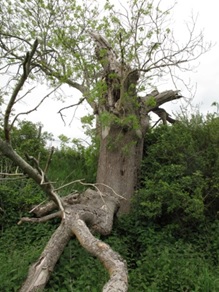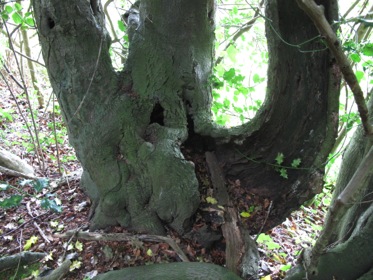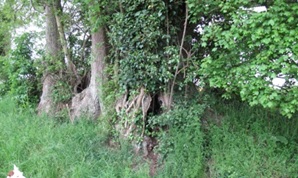Mighty trees, usually oaks, but sometimes ash, willows, beech and even field maple punctuate Binsted Woods and the surrounding field margins.

These trees, some of which are two metres wide, have stood on the same spot for hundreds of years gazing upon the land. They have seen Kings and Queens come and go and survived through war and peace; some, mere saplings during the reign of Charles I in the 17th Century; standing tall when Victoria took the throne.
Trees cannot shelter from high winds, storms, lightening and fire. They cannot fight back when a hungry deer is stripping their bark in the depths of winter, or a woodpecker decides to drum through carefully laid down layers of wood to create a safe nest cavity. These trees have survived the axe and, later, the chainsaw, and live to show and carry such scars of life in the form of lost branches and bark, splits, holes, and dead limbs. These features classify a tree as a ‘veteran’; a term that carries strong connotations of old battle scars, which in all reality they are.
This all sounds pretty bleak, but trees are made of stronger stuff and soldier on, isolating damaged areas where possible. Moreover, these old soldiers become home to an army of different organisms that can utilize this vast range of different nooks and crannies.

Fungal spores landing on a spot devoid of protective bark rapidly exploit this fortune and send out hyphae that break down lignin. In turn many beetle larvae who live on dead wood (and are amongst our rarest invertebrates) find wood that has first been attacked by fungi softer and easier to digest, and can therefore grow more quickly. The fungal fruiting bodies form brackets outside the trunk which, in turn, are home to tiny beetles living in pores, fly larvae, moths, mites, and more.
Some spiders live and hunt under loose bark, never leaving the tree. Armies of ants scale mighty trees, foraging amongst mosses and lichens, looking for tasty unfortunates to take back to the nest; many birds nest in safe hollows and cracks in the wood; ladybirds and butterflies overwinter in tiny sheltered spaces.
Most British bats evolved to roost in trees, in gaps beneath the bark, splits, and in holes. Females, each raising a pup, roost together in ‘maternity roosts’ in deep hollows that are safely enclosed by insulating wood.

These trees support entire ecosystems; they have see many centuries come and go and with time they have become more scarred, and in doing so, have supported hundreds of generations of life. Old age in these Arundel area veterans is truly something to be treasured.
Jackie Thompson
MAVES Project Manager
Consultant Ecologist: Wildlife Splash Ltd
